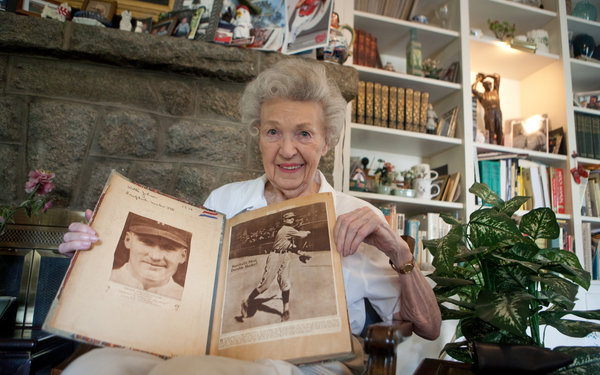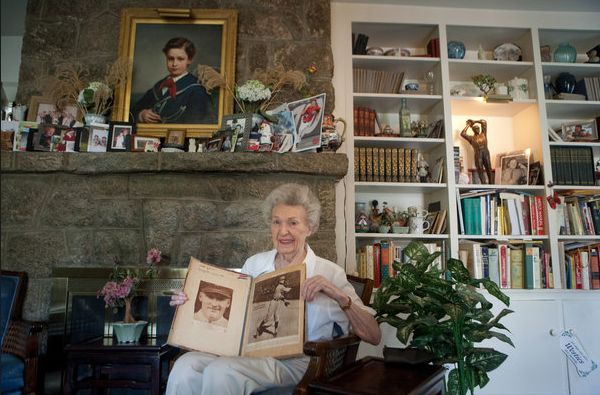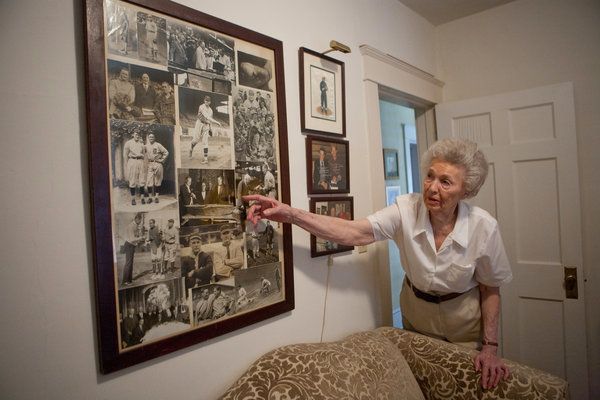Big Train Is Still Rolling
By HILLEL KUTTLER
Published: October 9, 2012

Carolyn Thomas, 89, with a scrapbook made in 1924 by the wife of her father, Walter Johnson.
Photos by Daniel Rosenbaum for The New York Times
WASHINGTON — A stranger recently telephoned Carolyn Thomas to ask how old she was when her father died. Twenty-three, she replied.
"Oh, you knew him!" the man, greatly impressed, responded. Thomas could only laugh.
For sports fans in this city, Thomas's father, Walter Johnson, remains royalty 85 years after his sidearm fastball last whizzed past a helpless batter and 66 years since his death. The Washington Senators' pitching ace, Johnson won 417 games, the second most in baseball history, and his 3,509 strikeouts stood as a major league record until 1983. The Big Train, as he was known, retains numerous baseball career marks, with perhaps the most impressive being his throwing 110 shutouts and 531 complete games in 21 seasons, all with Washington.
Late in Johnson's career, the Senators brought home the capital's lone World Series championship. Johnson pitched the final four innings of the decisive seventh game in 1924, a 12-inning 4-3 victory over the New York Giants on Oct. 10. His other two World Series wins came in 1925, when the Pittsburgh Pirates took the title in seven games.
Johnson's Senators played in the American League and later moved to Minnesota, and a second Senators team moved to Texas a decade later. Now, Washington is in the National League and its Nationals will play here Wednesday afternoon in Game 3 of their division series against St. Louis. It will be the first postseason baseball in this city in 79 years, and Johnson's daughter, now 89, is following along avidly.
The little girl turned great-grandmother represents one of the last direct connections to her father's life. Her only remaining sibling, Edwin, died at 94 in August. According to the Baseball Hall of Fame, no one is alive now who played in the major leagues when Johnson pitched and managed.
Thomas watches many Nationals games on television and reads newspaper articles about the team, which relocated here from Montreal in 2005. A color photograph of the rookie outfielder Bryce Harper graces her living room mantel, next to a stuffed-eagle doll in a Nationals uniform. On a nearby bookshelf rests a baseball signed by the team's former first baseman Dmitri Young. "You are the sweetest lady," Young wrote on it.
"Harper's exciting. He makes things happen. He's a little spark plug," Thomas, with a twinkle in her eye, told a visitor one recent afternoon. "Davey Johnson," she said of the Nationals' manager, "he's a baseball man. He knows the game."
Even while she praises members of today's team, one Washington player rises above all: her famous father, who raised five children (a sixth died at 2) after his wife, Hazel, succumbed to heatstroke in 1930. Thomas was just 7 then. Johnson also raised his late sister's two children, with help from his mother, Minnie, who moved here from Kansas.
"He was a good role model: not judgmental, pious, just a nice guy," said Thomas, a warm and attentive woman who is also tall, like her father. "We just adored him."
The white clapboard house in which Thomas has lived since 1955 is a daughter's informal shrine to her father. Walking over to the bookshelf, she reaches behind the Young baseball to grasp a bronze statuette of her father. The pitcher's hands are perched above his head as if preparing to uncoil into his famed, whiplike motion.

In a nod to Washington baseball history, the Nationals commissioned a Johnson statue, but Thomas says she hates it. So does her son and Johnson biographer, Henry Thomas, 66. They did not attend the 2009 ceremony at which it was unveiled alongside statues honoring the Senators slugger Frank Howard and the Negro leagues star Josh Gibson.
The Johnson statue, situated in a Nationals Park concourse and depicting the pitcher releasing the ball with multiple arms, should be done in "with an acetylene torch," said her son, who was visiting on the day his mother was interviewed. He was not smiling.
The Nationals are making amends. They now plan to dedicate an eight-foot-tall Johnson monument, a replica of the one that President Harry S. Truman unveiled at Griffith Stadium, then the home of the Washington Senators, in June 1947. It was shortly after Johnson's death. The original monument now stands at the entrance to Walter Johnson High School in Bethesda, Md.
Phil Wood, a longtime Washington broadcaster, remembers his father showing him the monument at a game they attended in 1956. "I recall my father pointing at it and saying, 'He was the greatest pitcher who ever lived,' " Wood said of the visit.
It's a sentiment with which Wood, a baseball historian, concurs. Johnson "was to pitching what Babe Ruth was to hitting," Wood said.
"He was a great pitcher on a bad club most of his career," Wood added. "His record as a manager was outstanding. The guy was such a solid citizen. He was the genuine article."
Thomas told her visitor she was thrilled with the Nationals' plan to honor her father. Then she stood up. "Would you like to see the den?" she offered.
That room is where Thomas watches most ballgames and where her father's presence permeates. Near the flat-screen television is a poster of a Walter Johnson postage stamp. On another wall hangs a framed collage that Hazel Johnson assembled for a banquet preceding opening day in 1929, her husband's first game as the manager of the Senators.

Carolyn Thomas, 89, showing a collage made by Walter Johnson's wife, Hazel, that hangs in her house in Washington.
The collage features lovely photographs: Johnson posing in the uniform of the Weiser Kids, an Idaho town team for which he pitched in 1906 and 1907 before the Senators signed him; Johnson shaking hands with the Giants' Christy Mathewson before a 1913 exhibition game, the only matchup of the right-handed pitchers; Johnson on the set of "The Thief of Baghdad" with the 1924 film's star, Douglas Fairbanks, and Ruth. Another photograph shows Thomas at age 1, wearing a white bonnet and with her father, in uniform, looking on at Griffith Stadium. In it, she is perched in an oversize mitt belonging to pitcher Al Schacht, Johnson's teammate, who later became known as the Clown Prince of Baseball.
Thomas was too young to see Johnson play in either of the two World Series in which he participated and does not remember the Senators' 1933 World Series appearance because she and her friends did not pay baseball any mind then.
The next year, though, she met Ruth during one of the summers she spent in Cleveland while her father managed the Indians. Ruth, staying with the Yankees in the same hotel as the Johnsons, told her and her sister, Barbara, to ignore the criticism of their father in the local sports pages. She appreciated the sentiment.
Eating breakfast soon afterward, she was smitten with Ruth's teammate, who sat at a table nearby.
"I was entranced by Lou Gehrig's dimples," Thomas said. "He had wonderful dimples."
Thomas's family says that Thomas and Julia Ruth Stevens (Ruth's stepdaughter) are the sole surviving children of the original five Cooperstown inductees from 1936, but the Hall of Fame could not confirm that.
But even one who is among the last has a first in mind. Thomas has never attended a game in the eight seasons the Nationals have called Washington home. Should this team reach the World Series, though, she promises to be at the ballpark, cheering them on.
"I think we have great potential, and a wonderful bullpen," she said. "I like them all. We're really going places."